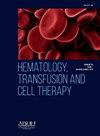高危基因突变对接受二次自体干细胞移植的多发性骨髓瘤患者预后的影响
IF 1.6
Q3 HEMATOLOGY
引用次数: 0
摘要
目的高危基因突变显著影响多发性骨髓瘤的预后。尽管自体造血干细胞移植(auto-HSCT)是多发性骨髓瘤治疗的基石,但基因异常对接受第二次自体造血干细胞移植患者预后的影响仍有待进一步研究。本研究旨在评估高风险基因突变在多发性骨髓瘤患者接受第二次自体造血干细胞移植中的预后意义。该回顾性分析评估了2017年5月5日至2024年12月10日期间接受第二次自体造血干细胞移植的26例多发性骨髓瘤患者。对19例移植前荧光原位杂交(FISH)数据进行了详细分析。其中,9例患者接受了串联移植,10例患者接受了非串联第二次自体造血干细胞移植。预后分析侧重于FISH检测到的遗传异常。结果男性10例(52.6%),女性9例(47.4%),平均年龄56.79岁(SD = 10.39,范围34 ~ 69)。第二次移植后中位随访时间为31个月(IQR 18-54)。两次移植之间的中位间隔为16个月(IQR 4-72.5)和62个月(IQR 31-93),不包括串联病例。19例分析患者中有11例(57.9%)检测到高危基因突变:缺失17p和扩增1q(各26.3%),t(4;14)(15.8%),缺失1p (10.5%), t(14;16)(5.3%)。高危突变患者的死亡率更高(54.5% vs. 25%),尽管总体上没有统计学意义(p = 0.198)。扩增1q与死亡率增加显著相关(80% vs. 28.6%, p = 0.048)。Kaplan-Meier分析显示,≥2个高危突变患者的总生存期显著缩短(16.10 vs. 59.43个月,p = 0.017),扩增1q (32.50 vs. 60.57个月,p = 0.048),缺失17p (18.50 vs. 59.12个月,p = 0.030)。至少有一个高危突变的患者血小板移植明显延迟(12.64天vs. 10.88天,p = 0.033)。中性粒细胞植入与住院时间无显著差异。移植前血红蛋白、血小板和中性粒细胞计数与存活、移植时间或住院时间无关。串联移植组和非串联移植组的生存结果相似;然而,在串联亚组中,基因突变与较高的死亡率相关(66.7% vs. 0%, p = 0.058)。结论高风险基因突变,特别是1q扩增和17p缺失,显著预测多发性骨髓瘤患者第二次自体造血干细胞移植(auto-HSCT)后较差的生存结果。携带这些突变的患者表现出更高的死亡率和延迟的血小板植入,强调了移植前基因谱的临床重要性。通过FISH分析早期识别这些遗传异常可以实现更精确的风险分层,指导个性化治疗方法,并有可能改善多发性骨髓瘤的临床管理和患者预后。本文章由计算机程序翻译,如有差异,请以英文原文为准。
PROGNOSTIC IMPLICATIONS OF HIGH-RISK GENETIC MUTATIONS IN MULTIPLE MYELOMA PATIENTS UNDERGOING SECOND AUTOLOGOUS STEM CELL TRANSPLANT
Objective
High-risk genetic mutations significantly influence prognosis in multiple myeloma. Although autologous Hematopoietic Stem Cell Transplantation (auto-HSCT) is a cornerstone of multiple myeloma treatment, the prognostic impact of genetic abnormalities in patients undergoing a second auto-HSCT warrants further investigation. This study aims to evaluate the prognostic significance of high-risk genetic mutations in multiple myeloma patients undergoing a second auto-HSCT.
Methodology
This retrospective analysis evaluated 26 multiple myeloma patients who underwent a second auto-HSCT between May 5, 2017, and December 10, 2024. Detailed analysis was conducted on 19 patients with available pre-transplant Fluorescence In Situ Hybridization (FISH) data. Among these, 9 patients underwent tandem transplantation, and 10 underwent a non-tandem second auto-HSCT. Prognostic analyses focused on genetic abnormalities detected by FISH.
Results
The analyzed cohort included 10 males (52.6%) and 9 females (47.4%), with a mean age of 56.79-years (SD = 10.39, range 34–69). Median follow-up post-second transplantation was 31-months (IQR 18–54). Median intervals between two transplantations were 16-months (IQR 4–72.5) overall and 62-months (IQR 31–93) excluding tandem cases. High-risk genetic mutations were detected in 11 of 19 analyzed patients (57.9%): deletion 17p and amplification 1q (each 26.3%), t(4;14) (15.8%), deletion 1p (10.5%), and t(14;16) (5.3%). Patients with high-risk mutations had a higher mortality rate (54.5% vs. 25%), although not statistically significant overall (p = 0.198). Amplification 1q was significantly associated with increased mortality (80% vs. 28.6%, p = 0.048). Kaplan-Meier analysis revealed significantly shorter overall survival for patients with ≥ 2 high-risk mutations (16.10 vs. 59.43 months, p = 0.017), amplification 1q (32.50 vs. 60.57 months, p = 0.048), and deletion 17p (18.50 vs. 59.12 months, p = 0.030). Platelet engraftment was significantly delayed in patients with at least one high-risk mutation (12.64 vs. 10.88 days, p = 0.033). Neutrophil engraftment and hospital stay durations were not significantly different. Pre-transplant hemoglobin, platelet, and neutrophil counts showed no correlation with survival, engraftment times, or hospital stay duration. Survival outcomes were similar between tandem and non-tandem transplantation groups; however, within the tandem subgroup, genetic mutations were associated with higher mortality (66.7% vs. 0%, p = 0.058).
Conclusion
High-risk genetic mutations, particularly amplification 1q and deletion 17p, significantly predict poorer survival outcomes following second autologous Hematopoietic Stem Cell Transplantation (auto-HSCT) in multiple myeloma patients. Patients harboring these mutations exhibit higher mortality rates and delayed platelet engraftment, underscoring the clinical importance of pre-transplant genetic profiling. Early identification of these genetic abnormalities through FISH analysis could enable more precise risk stratification, guide personalized therapeutic approaches, and potentially improve clinical management and patient outcomes in multiple myeloma.
求助全文
通过发布文献求助,成功后即可免费获取论文全文。
去求助
来源期刊

Hematology, Transfusion and Cell Therapy
Multiple-
CiteScore
2.40
自引率
4.80%
发文量
1419
审稿时长
30 weeks
 求助内容:
求助内容: 应助结果提醒方式:
应助结果提醒方式:


